The Effects of Income Disparity on Chronic Illness and Health
VerifiedAdded on 2023/06/07
|12
|3789
|416
Essay
AI Summary
This essay delves into the significant effects of income disparity on chronic illness and overall health outcomes. The introduction establishes the prevalence of chronic illnesses and highlights income as a key factor in health disparities, contrasting the health experiences of the wealthy and the poor. The study examines how high income can lead to better access to healthcare, preventive measures, and education, thereby reducing the risk of chronic diseases. Conversely, it also acknowledges that the wealthy can be vulnerable to lifestyle-related illnesses due to factors like poor dietary choices, substance abuse, and social isolation. The essay further explores how low income often correlates with limited access to healthcare, balanced diets, and health insurance, leading to increased vulnerability to chronic diseases. The essay also touches upon the challenges in the Australian healthcare system and its impact on less affluent families. Overall, the essay provides a comprehensive analysis of the complex relationship between income, lifestyle, and chronic illness, arguing that both high and low income can have profound impacts on health outcomes.
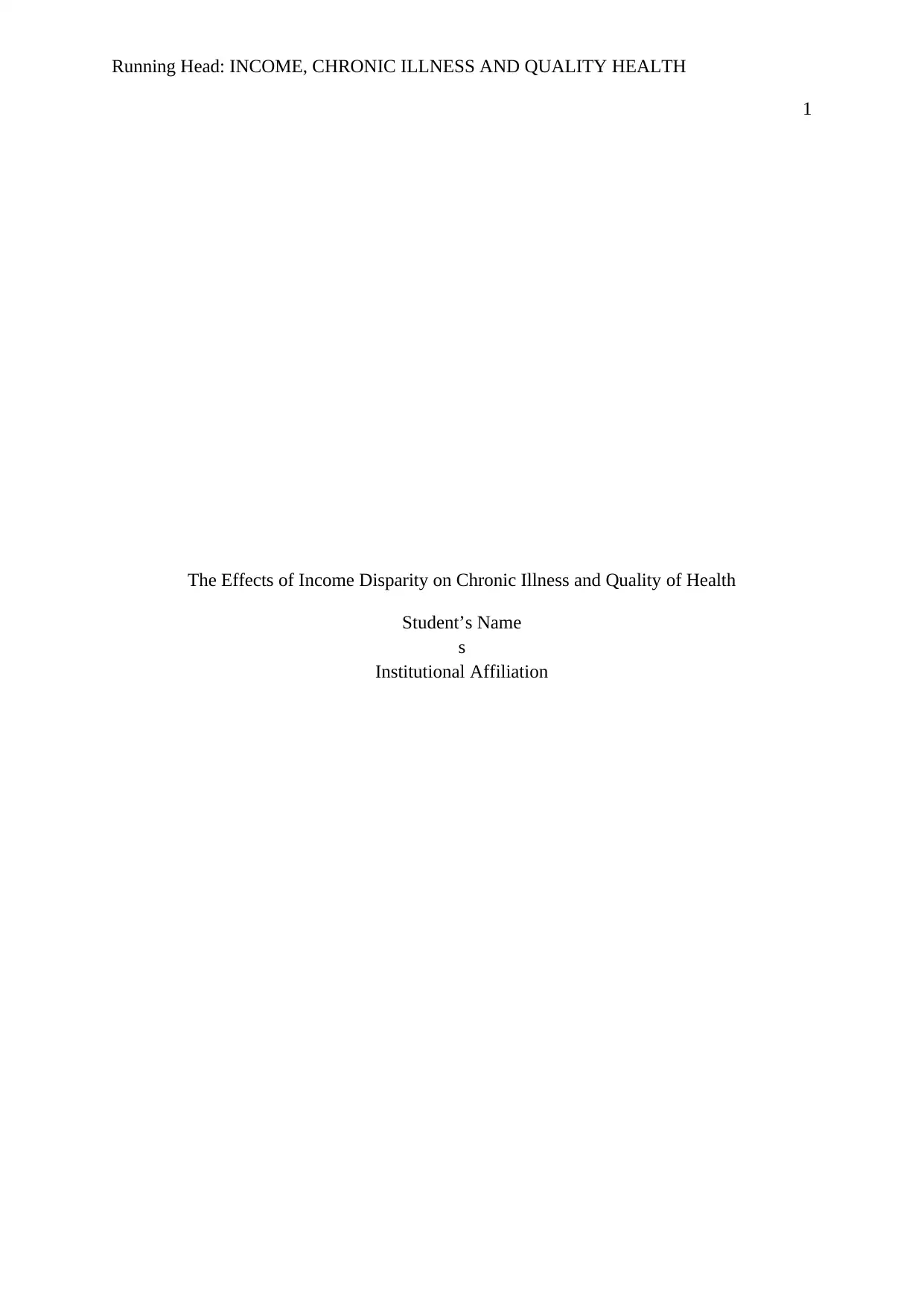
Running Head: INCOME, CHRONIC ILLNESS AND QUALITY HEALTH
1
The Effects of Income Disparity on Chronic Illness and Quality of Health
Student’s Name
s
Institutional Affiliation
1
The Effects of Income Disparity on Chronic Illness and Quality of Health
Student’s Name
s
Institutional Affiliation
Paraphrase This Document
Need a fresh take? Get an instant paraphrase of this document with our AI Paraphraser
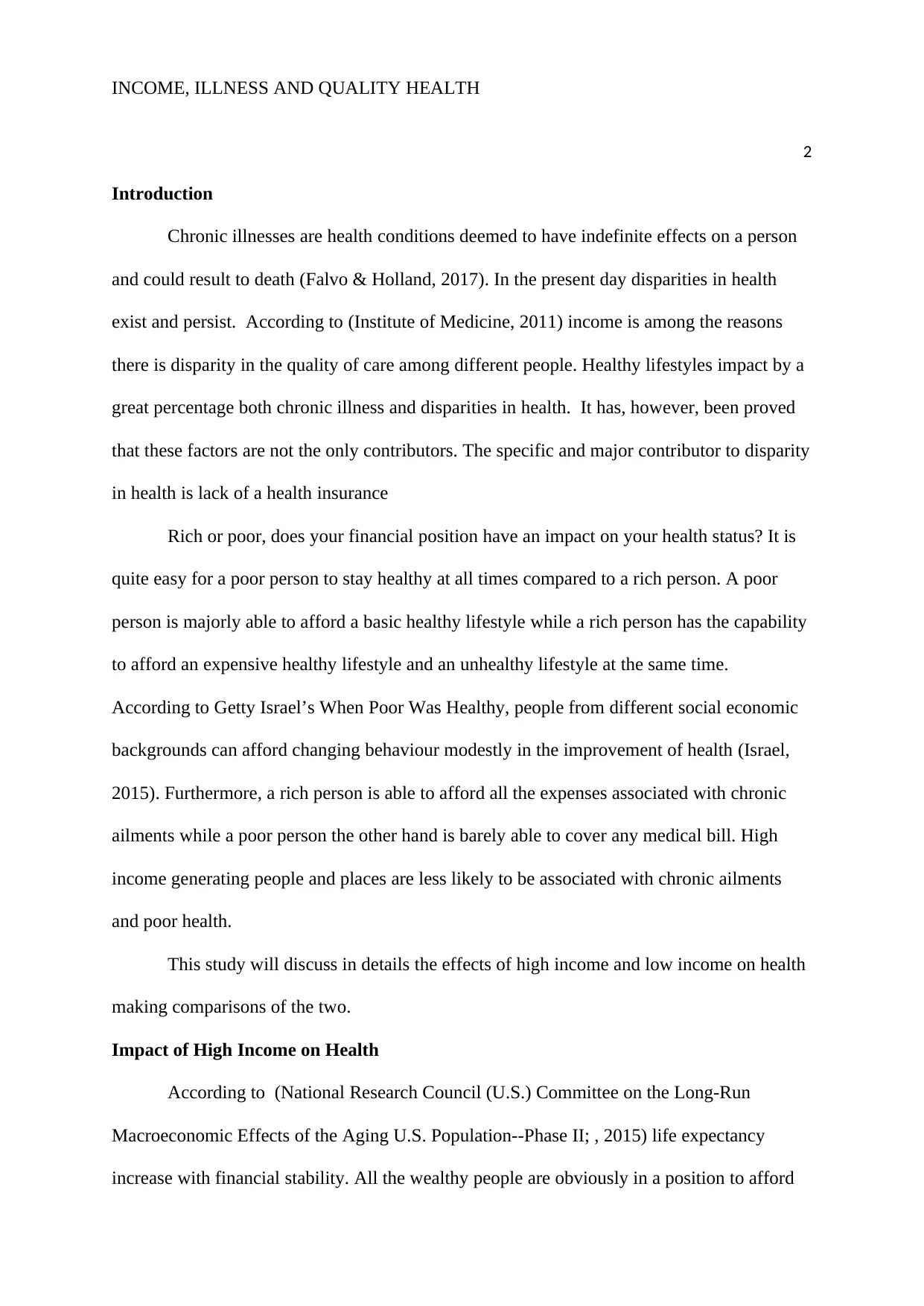
INCOME, ILLNESS AND QUALITY HEALTH
2
Introduction
Chronic illnesses are health conditions deemed to have indefinite effects on a person
and could result to death (Falvo & Holland, 2017). In the present day disparities in health
exist and persist. According to (Institute of Medicine, 2011) income is among the reasons
there is disparity in the quality of care among different people. Healthy lifestyles impact by a
great percentage both chronic illness and disparities in health. It has, however, been proved
that these factors are not the only contributors. The specific and major contributor to disparity
in health is lack of a health insurance
Rich or poor, does your financial position have an impact on your health status? It is
quite easy for a poor person to stay healthy at all times compared to a rich person. A poor
person is majorly able to afford a basic healthy lifestyle while a rich person has the capability
to afford an expensive healthy lifestyle and an unhealthy lifestyle at the same time.
According to Getty Israel’s When Poor Was Healthy, people from different social economic
backgrounds can afford changing behaviour modestly in the improvement of health (Israel,
2015). Furthermore, a rich person is able to afford all the expenses associated with chronic
ailments while a poor person the other hand is barely able to cover any medical bill. High
income generating people and places are less likely to be associated with chronic ailments
and poor health.
This study will discuss in details the effects of high income and low income on health
making comparisons of the two.
Impact of High Income on Health
According to (National Research Council (U.S.) Committee on the Long-Run
Macroeconomic Effects of the Aging U.S. Population--Phase II; , 2015) life expectancy
increase with financial stability. All the wealthy people are obviously in a position to afford
2
Introduction
Chronic illnesses are health conditions deemed to have indefinite effects on a person
and could result to death (Falvo & Holland, 2017). In the present day disparities in health
exist and persist. According to (Institute of Medicine, 2011) income is among the reasons
there is disparity in the quality of care among different people. Healthy lifestyles impact by a
great percentage both chronic illness and disparities in health. It has, however, been proved
that these factors are not the only contributors. The specific and major contributor to disparity
in health is lack of a health insurance
Rich or poor, does your financial position have an impact on your health status? It is
quite easy for a poor person to stay healthy at all times compared to a rich person. A poor
person is majorly able to afford a basic healthy lifestyle while a rich person has the capability
to afford an expensive healthy lifestyle and an unhealthy lifestyle at the same time.
According to Getty Israel’s When Poor Was Healthy, people from different social economic
backgrounds can afford changing behaviour modestly in the improvement of health (Israel,
2015). Furthermore, a rich person is able to afford all the expenses associated with chronic
ailments while a poor person the other hand is barely able to cover any medical bill. High
income generating people and places are less likely to be associated with chronic ailments
and poor health.
This study will discuss in details the effects of high income and low income on health
making comparisons of the two.
Impact of High Income on Health
According to (National Research Council (U.S.) Committee on the Long-Run
Macroeconomic Effects of the Aging U.S. Population--Phase II; , 2015) life expectancy
increase with financial stability. All the wealthy people are obviously in a position to afford
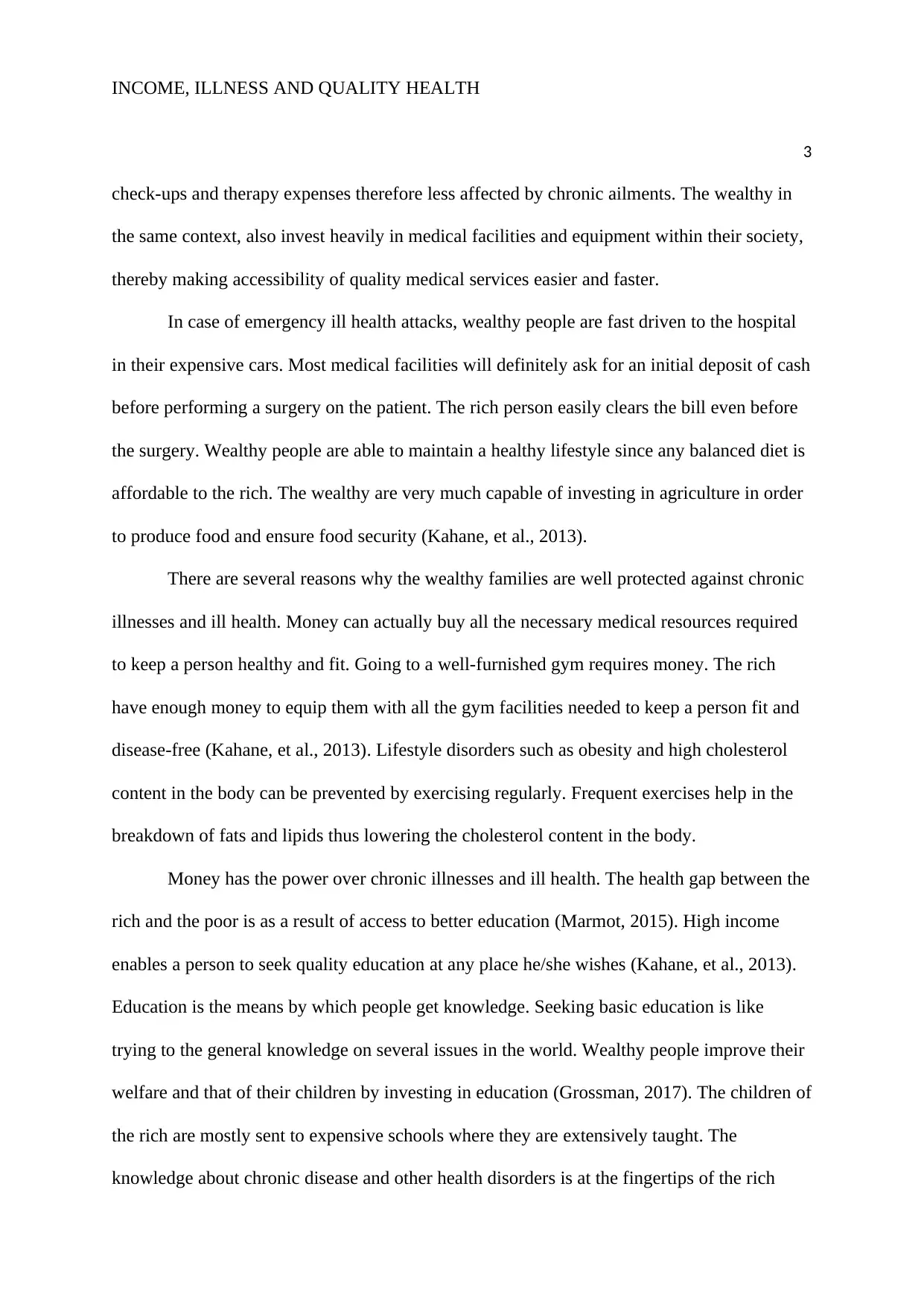
INCOME, ILLNESS AND QUALITY HEALTH
3
check-ups and therapy expenses therefore less affected by chronic ailments. The wealthy in
the same context, also invest heavily in medical facilities and equipment within their society,
thereby making accessibility of quality medical services easier and faster.
In case of emergency ill health attacks, wealthy people are fast driven to the hospital
in their expensive cars. Most medical facilities will definitely ask for an initial deposit of cash
before performing a surgery on the patient. The rich person easily clears the bill even before
the surgery. Wealthy people are able to maintain a healthy lifestyle since any balanced diet is
affordable to the rich. The wealthy are very much capable of investing in agriculture in order
to produce food and ensure food security (Kahane, et al., 2013).
There are several reasons why the wealthy families are well protected against chronic
illnesses and ill health. Money can actually buy all the necessary medical resources required
to keep a person healthy and fit. Going to a well-furnished gym requires money. The rich
have enough money to equip them with all the gym facilities needed to keep a person fit and
disease-free (Kahane, et al., 2013). Lifestyle disorders such as obesity and high cholesterol
content in the body can be prevented by exercising regularly. Frequent exercises help in the
breakdown of fats and lipids thus lowering the cholesterol content in the body.
Money has the power over chronic illnesses and ill health. The health gap between the
rich and the poor is as a result of access to better education (Marmot, 2015). High income
enables a person to seek quality education at any place he/she wishes (Kahane, et al., 2013).
Education is the means by which people get knowledge. Seeking basic education is like
trying to the general knowledge on several issues in the world. Wealthy people improve their
welfare and that of their children by investing in education (Grossman, 2017). The children of
the rich are mostly sent to expensive schools where they are extensively taught. The
knowledge about chronic disease and other health disorders is at the fingertips of the rich
3
check-ups and therapy expenses therefore less affected by chronic ailments. The wealthy in
the same context, also invest heavily in medical facilities and equipment within their society,
thereby making accessibility of quality medical services easier and faster.
In case of emergency ill health attacks, wealthy people are fast driven to the hospital
in their expensive cars. Most medical facilities will definitely ask for an initial deposit of cash
before performing a surgery on the patient. The rich person easily clears the bill even before
the surgery. Wealthy people are able to maintain a healthy lifestyle since any balanced diet is
affordable to the rich. The wealthy are very much capable of investing in agriculture in order
to produce food and ensure food security (Kahane, et al., 2013).
There are several reasons why the wealthy families are well protected against chronic
illnesses and ill health. Money can actually buy all the necessary medical resources required
to keep a person healthy and fit. Going to a well-furnished gym requires money. The rich
have enough money to equip them with all the gym facilities needed to keep a person fit and
disease-free (Kahane, et al., 2013). Lifestyle disorders such as obesity and high cholesterol
content in the body can be prevented by exercising regularly. Frequent exercises help in the
breakdown of fats and lipids thus lowering the cholesterol content in the body.
Money has the power over chronic illnesses and ill health. The health gap between the
rich and the poor is as a result of access to better education (Marmot, 2015). High income
enables a person to seek quality education at any place he/she wishes (Kahane, et al., 2013).
Education is the means by which people get knowledge. Seeking basic education is like
trying to the general knowledge on several issues in the world. Wealthy people improve their
welfare and that of their children by investing in education (Grossman, 2017). The children of
the rich are mostly sent to expensive schools where they are extensively taught. The
knowledge about chronic disease and other health disorders is at the fingertips of the rich
⊘ This is a preview!⊘
Do you want full access?
Subscribe today to unlock all pages.

Trusted by 1+ million students worldwide
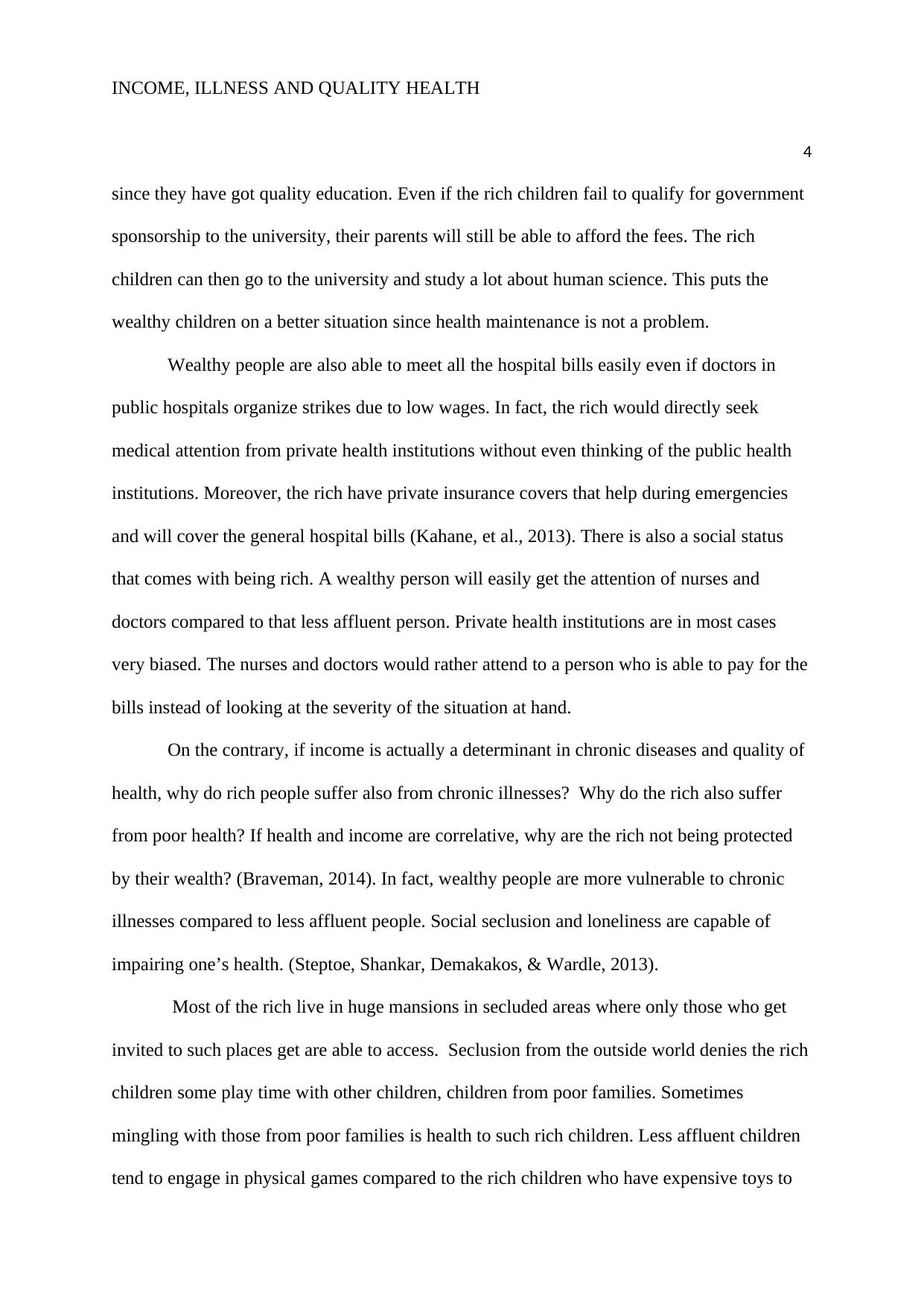
INCOME, ILLNESS AND QUALITY HEALTH
4
since they have got quality education. Even if the rich children fail to qualify for government
sponsorship to the university, their parents will still be able to afford the fees. The rich
children can then go to the university and study a lot about human science. This puts the
wealthy children on a better situation since health maintenance is not a problem.
Wealthy people are also able to meet all the hospital bills easily even if doctors in
public hospitals organize strikes due to low wages. In fact, the rich would directly seek
medical attention from private health institutions without even thinking of the public health
institutions. Moreover, the rich have private insurance covers that help during emergencies
and will cover the general hospital bills (Kahane, et al., 2013). There is also a social status
that comes with being rich. A wealthy person will easily get the attention of nurses and
doctors compared to that less affluent person. Private health institutions are in most cases
very biased. The nurses and doctors would rather attend to a person who is able to pay for the
bills instead of looking at the severity of the situation at hand.
On the contrary, if income is actually a determinant in chronic diseases and quality of
health, why do rich people suffer also from chronic illnesses? Why do the rich also suffer
from poor health? If health and income are correlative, why are the rich not being protected
by their wealth? (Braveman, 2014). In fact, wealthy people are more vulnerable to chronic
illnesses compared to less affluent people. Social seclusion and loneliness are capable of
impairing one’s health. (Steptoe, Shankar, Demakakos, & Wardle, 2013).
Most of the rich live in huge mansions in secluded areas where only those who get
invited to such places get are able to access. Seclusion from the outside world denies the rich
children some play time with other children, children from poor families. Sometimes
mingling with those from poor families is health to such rich children. Less affluent children
tend to engage in physical games compared to the rich children who have expensive toys to
4
since they have got quality education. Even if the rich children fail to qualify for government
sponsorship to the university, their parents will still be able to afford the fees. The rich
children can then go to the university and study a lot about human science. This puts the
wealthy children on a better situation since health maintenance is not a problem.
Wealthy people are also able to meet all the hospital bills easily even if doctors in
public hospitals organize strikes due to low wages. In fact, the rich would directly seek
medical attention from private health institutions without even thinking of the public health
institutions. Moreover, the rich have private insurance covers that help during emergencies
and will cover the general hospital bills (Kahane, et al., 2013). There is also a social status
that comes with being rich. A wealthy person will easily get the attention of nurses and
doctors compared to that less affluent person. Private health institutions are in most cases
very biased. The nurses and doctors would rather attend to a person who is able to pay for the
bills instead of looking at the severity of the situation at hand.
On the contrary, if income is actually a determinant in chronic diseases and quality of
health, why do rich people suffer also from chronic illnesses? Why do the rich also suffer
from poor health? If health and income are correlative, why are the rich not being protected
by their wealth? (Braveman, 2014). In fact, wealthy people are more vulnerable to chronic
illnesses compared to less affluent people. Social seclusion and loneliness are capable of
impairing one’s health. (Steptoe, Shankar, Demakakos, & Wardle, 2013).
Most of the rich live in huge mansions in secluded areas where only those who get
invited to such places get are able to access. Seclusion from the outside world denies the rich
children some play time with other children, children from poor families. Sometimes
mingling with those from poor families is health to such rich children. Less affluent children
tend to engage in physical games compared to the rich children who have expensive toys to
Paraphrase This Document
Need a fresh take? Get an instant paraphrase of this document with our AI Paraphraser
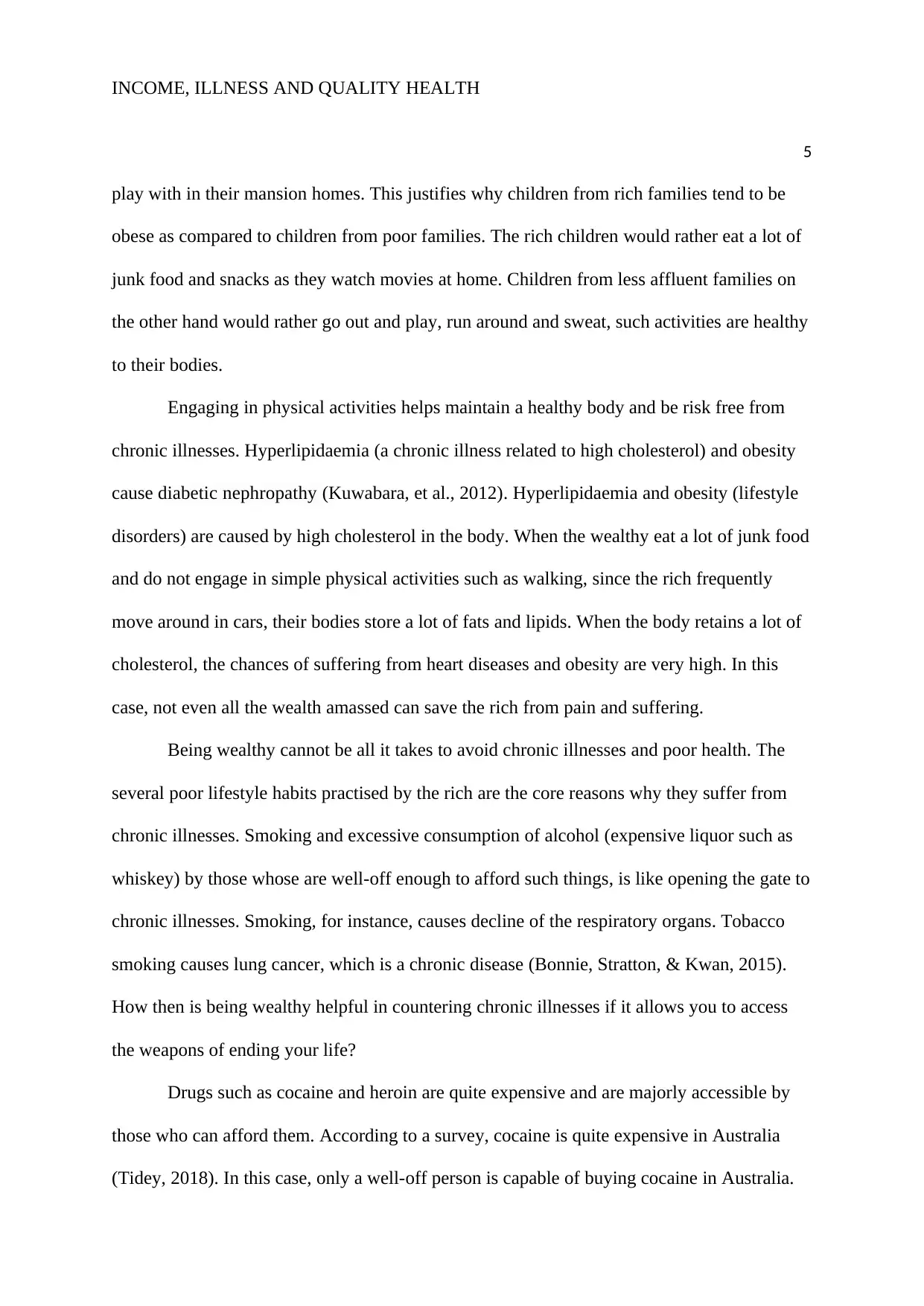
INCOME, ILLNESS AND QUALITY HEALTH
5
play with in their mansion homes. This justifies why children from rich families tend to be
obese as compared to children from poor families. The rich children would rather eat a lot of
junk food and snacks as they watch movies at home. Children from less affluent families on
the other hand would rather go out and play, run around and sweat, such activities are healthy
to their bodies.
Engaging in physical activities helps maintain a healthy body and be risk free from
chronic illnesses. Hyperlipidaemia (a chronic illness related to high cholesterol) and obesity
cause diabetic nephropathy (Kuwabara, et al., 2012). Hyperlipidaemia and obesity (lifestyle
disorders) are caused by high cholesterol in the body. When the wealthy eat a lot of junk food
and do not engage in simple physical activities such as walking, since the rich frequently
move around in cars, their bodies store a lot of fats and lipids. When the body retains a lot of
cholesterol, the chances of suffering from heart diseases and obesity are very high. In this
case, not even all the wealth amassed can save the rich from pain and suffering.
Being wealthy cannot be all it takes to avoid chronic illnesses and poor health. The
several poor lifestyle habits practised by the rich are the core reasons why they suffer from
chronic illnesses. Smoking and excessive consumption of alcohol (expensive liquor such as
whiskey) by those whose are well-off enough to afford such things, is like opening the gate to
chronic illnesses. Smoking, for instance, causes decline of the respiratory organs. Tobacco
smoking causes lung cancer, which is a chronic disease (Bonnie, Stratton, & Kwan, 2015).
How then is being wealthy helpful in countering chronic illnesses if it allows you to access
the weapons of ending your life?
Drugs such as cocaine and heroin are quite expensive and are majorly accessible by
those who can afford them. According to a survey, cocaine is quite expensive in Australia
(Tidey, 2018). In this case, only a well-off person is capable of buying cocaine in Australia.
5
play with in their mansion homes. This justifies why children from rich families tend to be
obese as compared to children from poor families. The rich children would rather eat a lot of
junk food and snacks as they watch movies at home. Children from less affluent families on
the other hand would rather go out and play, run around and sweat, such activities are healthy
to their bodies.
Engaging in physical activities helps maintain a healthy body and be risk free from
chronic illnesses. Hyperlipidaemia (a chronic illness related to high cholesterol) and obesity
cause diabetic nephropathy (Kuwabara, et al., 2012). Hyperlipidaemia and obesity (lifestyle
disorders) are caused by high cholesterol in the body. When the wealthy eat a lot of junk food
and do not engage in simple physical activities such as walking, since the rich frequently
move around in cars, their bodies store a lot of fats and lipids. When the body retains a lot of
cholesterol, the chances of suffering from heart diseases and obesity are very high. In this
case, not even all the wealth amassed can save the rich from pain and suffering.
Being wealthy cannot be all it takes to avoid chronic illnesses and poor health. The
several poor lifestyle habits practised by the rich are the core reasons why they suffer from
chronic illnesses. Smoking and excessive consumption of alcohol (expensive liquor such as
whiskey) by those whose are well-off enough to afford such things, is like opening the gate to
chronic illnesses. Smoking, for instance, causes decline of the respiratory organs. Tobacco
smoking causes lung cancer, which is a chronic disease (Bonnie, Stratton, & Kwan, 2015).
How then is being wealthy helpful in countering chronic illnesses if it allows you to access
the weapons of ending your life?
Drugs such as cocaine and heroin are quite expensive and are majorly accessible by
those who can afford them. According to a survey, cocaine is quite expensive in Australia
(Tidey, 2018). In this case, only a well-off person is capable of buying cocaine in Australia.
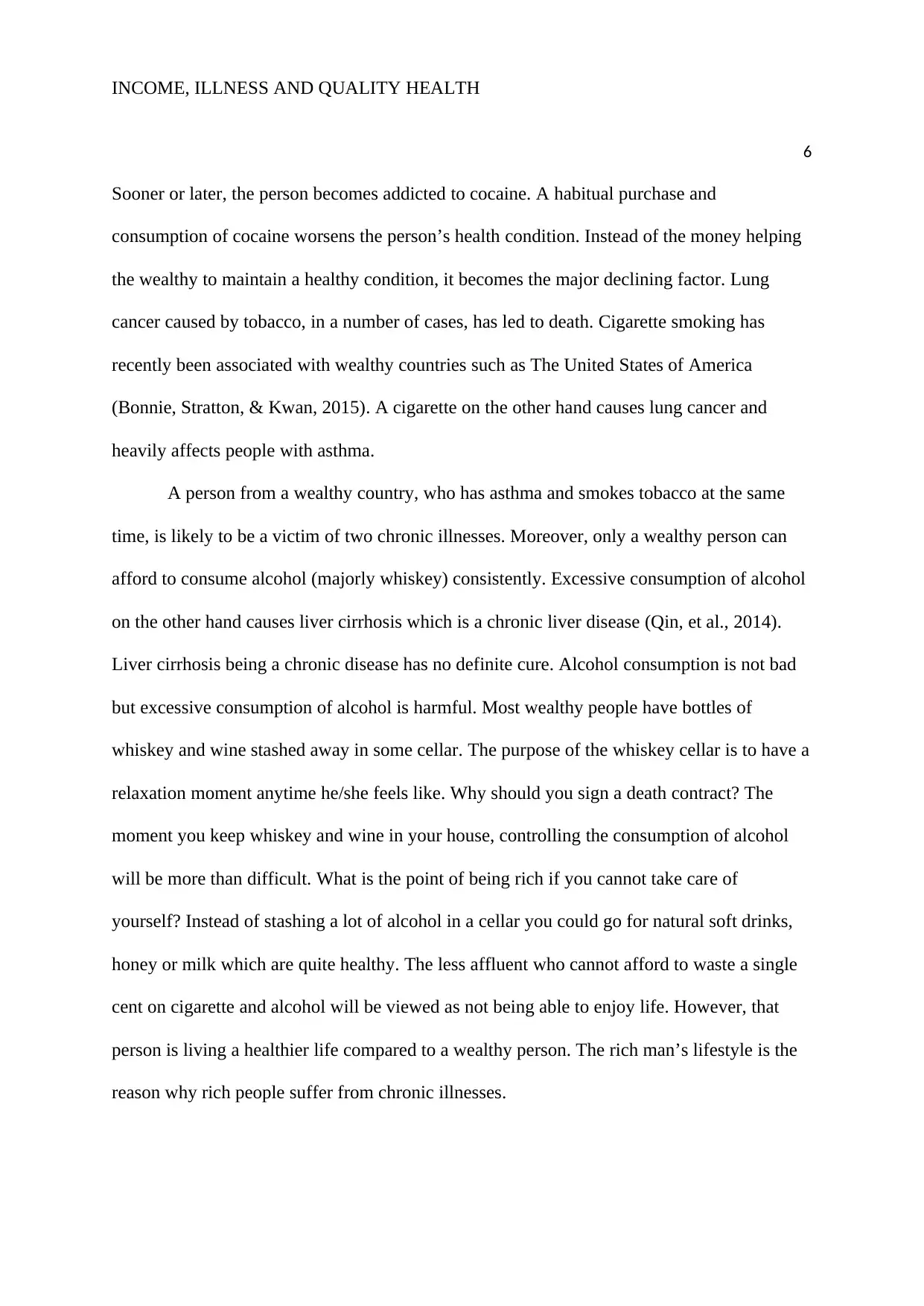
INCOME, ILLNESS AND QUALITY HEALTH
6
Sooner or later, the person becomes addicted to cocaine. A habitual purchase and
consumption of cocaine worsens the person’s health condition. Instead of the money helping
the wealthy to maintain a healthy condition, it becomes the major declining factor. Lung
cancer caused by tobacco, in a number of cases, has led to death. Cigarette smoking has
recently been associated with wealthy countries such as The United States of America
(Bonnie, Stratton, & Kwan, 2015). A cigarette on the other hand causes lung cancer and
heavily affects people with asthma.
A person from a wealthy country, who has asthma and smokes tobacco at the same
time, is likely to be a victim of two chronic illnesses. Moreover, only a wealthy person can
afford to consume alcohol (majorly whiskey) consistently. Excessive consumption of alcohol
on the other hand causes liver cirrhosis which is a chronic liver disease (Qin, et al., 2014).
Liver cirrhosis being a chronic disease has no definite cure. Alcohol consumption is not bad
but excessive consumption of alcohol is harmful. Most wealthy people have bottles of
whiskey and wine stashed away in some cellar. The purpose of the whiskey cellar is to have a
relaxation moment anytime he/she feels like. Why should you sign a death contract? The
moment you keep whiskey and wine in your house, controlling the consumption of alcohol
will be more than difficult. What is the point of being rich if you cannot take care of
yourself? Instead of stashing a lot of alcohol in a cellar you could go for natural soft drinks,
honey or milk which are quite healthy. The less affluent who cannot afford to waste a single
cent on cigarette and alcohol will be viewed as not being able to enjoy life. However, that
person is living a healthier life compared to a wealthy person. The rich man’s lifestyle is the
reason why rich people suffer from chronic illnesses.
6
Sooner or later, the person becomes addicted to cocaine. A habitual purchase and
consumption of cocaine worsens the person’s health condition. Instead of the money helping
the wealthy to maintain a healthy condition, it becomes the major declining factor. Lung
cancer caused by tobacco, in a number of cases, has led to death. Cigarette smoking has
recently been associated with wealthy countries such as The United States of America
(Bonnie, Stratton, & Kwan, 2015). A cigarette on the other hand causes lung cancer and
heavily affects people with asthma.
A person from a wealthy country, who has asthma and smokes tobacco at the same
time, is likely to be a victim of two chronic illnesses. Moreover, only a wealthy person can
afford to consume alcohol (majorly whiskey) consistently. Excessive consumption of alcohol
on the other hand causes liver cirrhosis which is a chronic liver disease (Qin, et al., 2014).
Liver cirrhosis being a chronic disease has no definite cure. Alcohol consumption is not bad
but excessive consumption of alcohol is harmful. Most wealthy people have bottles of
whiskey and wine stashed away in some cellar. The purpose of the whiskey cellar is to have a
relaxation moment anytime he/she feels like. Why should you sign a death contract? The
moment you keep whiskey and wine in your house, controlling the consumption of alcohol
will be more than difficult. What is the point of being rich if you cannot take care of
yourself? Instead of stashing a lot of alcohol in a cellar you could go for natural soft drinks,
honey or milk which are quite healthy. The less affluent who cannot afford to waste a single
cent on cigarette and alcohol will be viewed as not being able to enjoy life. However, that
person is living a healthier life compared to a wealthy person. The rich man’s lifestyle is the
reason why rich people suffer from chronic illnesses.
⊘ This is a preview!⊘
Do you want full access?
Subscribe today to unlock all pages.

Trusted by 1+ million students worldwide
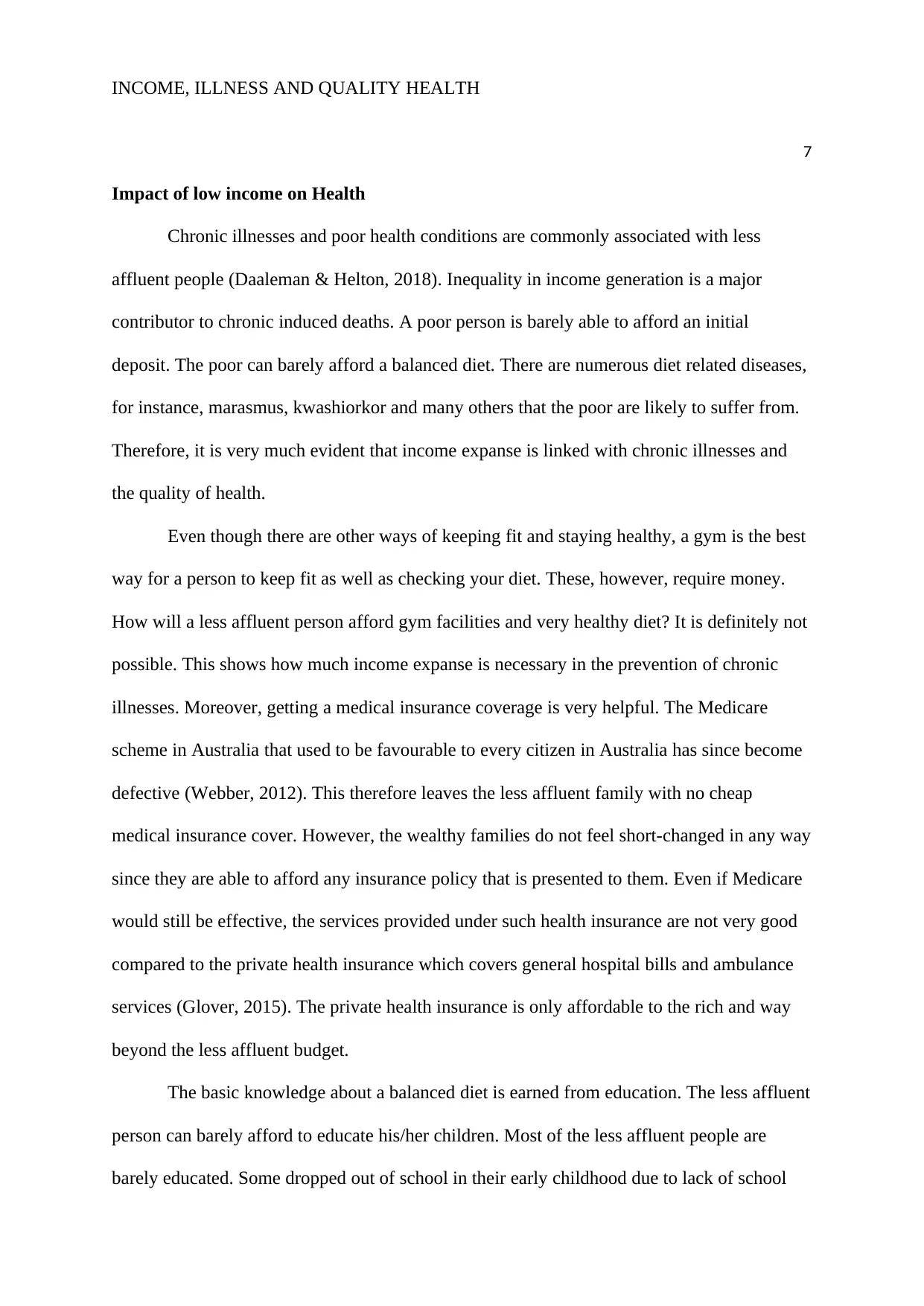
INCOME, ILLNESS AND QUALITY HEALTH
7
Impact of low income on Health
Chronic illnesses and poor health conditions are commonly associated with less
affluent people (Daaleman & Helton, 2018). Inequality in income generation is a major
contributor to chronic induced deaths. A poor person is barely able to afford an initial
deposit. The poor can barely afford a balanced diet. There are numerous diet related diseases,
for instance, marasmus, kwashiorkor and many others that the poor are likely to suffer from.
Therefore, it is very much evident that income expanse is linked with chronic illnesses and
the quality of health.
Even though there are other ways of keeping fit and staying healthy, a gym is the best
way for a person to keep fit as well as checking your diet. These, however, require money.
How will a less affluent person afford gym facilities and very healthy diet? It is definitely not
possible. This shows how much income expanse is necessary in the prevention of chronic
illnesses. Moreover, getting a medical insurance coverage is very helpful. The Medicare
scheme in Australia that used to be favourable to every citizen in Australia has since become
defective (Webber, 2012). This therefore leaves the less affluent family with no cheap
medical insurance cover. However, the wealthy families do not feel short-changed in any way
since they are able to afford any insurance policy that is presented to them. Even if Medicare
would still be effective, the services provided under such health insurance are not very good
compared to the private health insurance which covers general hospital bills and ambulance
services (Glover, 2015). The private health insurance is only affordable to the rich and way
beyond the less affluent budget.
The basic knowledge about a balanced diet is earned from education. The less affluent
person can barely afford to educate his/her children. Most of the less affluent people are
barely educated. Some dropped out of school in their early childhood due to lack of school
7
Impact of low income on Health
Chronic illnesses and poor health conditions are commonly associated with less
affluent people (Daaleman & Helton, 2018). Inequality in income generation is a major
contributor to chronic induced deaths. A poor person is barely able to afford an initial
deposit. The poor can barely afford a balanced diet. There are numerous diet related diseases,
for instance, marasmus, kwashiorkor and many others that the poor are likely to suffer from.
Therefore, it is very much evident that income expanse is linked with chronic illnesses and
the quality of health.
Even though there are other ways of keeping fit and staying healthy, a gym is the best
way for a person to keep fit as well as checking your diet. These, however, require money.
How will a less affluent person afford gym facilities and very healthy diet? It is definitely not
possible. This shows how much income expanse is necessary in the prevention of chronic
illnesses. Moreover, getting a medical insurance coverage is very helpful. The Medicare
scheme in Australia that used to be favourable to every citizen in Australia has since become
defective (Webber, 2012). This therefore leaves the less affluent family with no cheap
medical insurance cover. However, the wealthy families do not feel short-changed in any way
since they are able to afford any insurance policy that is presented to them. Even if Medicare
would still be effective, the services provided under such health insurance are not very good
compared to the private health insurance which covers general hospital bills and ambulance
services (Glover, 2015). The private health insurance is only affordable to the rich and way
beyond the less affluent budget.
The basic knowledge about a balanced diet is earned from education. The less affluent
person can barely afford to educate his/her children. Most of the less affluent people are
barely educated. Some dropped out of school in their early childhood due to lack of school
Paraphrase This Document
Need a fresh take? Get an instant paraphrase of this document with our AI Paraphraser
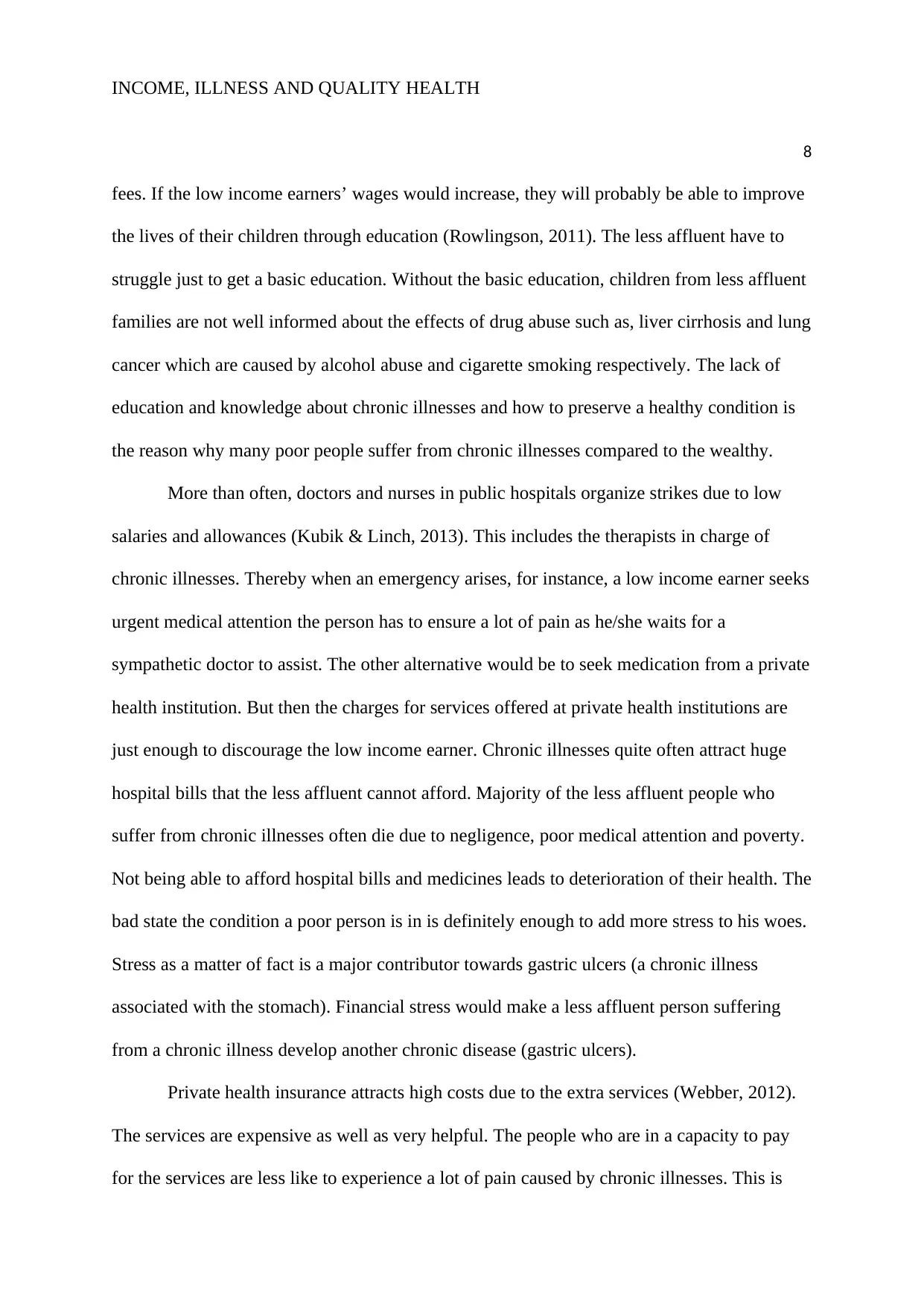
INCOME, ILLNESS AND QUALITY HEALTH
8
fees. If the low income earners’ wages would increase, they will probably be able to improve
the lives of their children through education (Rowlingson, 2011). The less affluent have to
struggle just to get a basic education. Without the basic education, children from less affluent
families are not well informed about the effects of drug abuse such as, liver cirrhosis and lung
cancer which are caused by alcohol abuse and cigarette smoking respectively. The lack of
education and knowledge about chronic illnesses and how to preserve a healthy condition is
the reason why many poor people suffer from chronic illnesses compared to the wealthy.
More than often, doctors and nurses in public hospitals organize strikes due to low
salaries and allowances (Kubik & Linch, 2013). This includes the therapists in charge of
chronic illnesses. Thereby when an emergency arises, for instance, a low income earner seeks
urgent medical attention the person has to ensure a lot of pain as he/she waits for a
sympathetic doctor to assist. The other alternative would be to seek medication from a private
health institution. But then the charges for services offered at private health institutions are
just enough to discourage the low income earner. Chronic illnesses quite often attract huge
hospital bills that the less affluent cannot afford. Majority of the less affluent people who
suffer from chronic illnesses often die due to negligence, poor medical attention and poverty.
Not being able to afford hospital bills and medicines leads to deterioration of their health. The
bad state the condition a poor person is in is definitely enough to add more stress to his woes.
Stress as a matter of fact is a major contributor towards gastric ulcers (a chronic illness
associated with the stomach). Financial stress would make a less affluent person suffering
from a chronic illness develop another chronic disease (gastric ulcers).
Private health insurance attracts high costs due to the extra services (Webber, 2012).
The services are expensive as well as very helpful. The people who are in a capacity to pay
for the services are less like to experience a lot of pain caused by chronic illnesses. This is
8
fees. If the low income earners’ wages would increase, they will probably be able to improve
the lives of their children through education (Rowlingson, 2011). The less affluent have to
struggle just to get a basic education. Without the basic education, children from less affluent
families are not well informed about the effects of drug abuse such as, liver cirrhosis and lung
cancer which are caused by alcohol abuse and cigarette smoking respectively. The lack of
education and knowledge about chronic illnesses and how to preserve a healthy condition is
the reason why many poor people suffer from chronic illnesses compared to the wealthy.
More than often, doctors and nurses in public hospitals organize strikes due to low
salaries and allowances (Kubik & Linch, 2013). This includes the therapists in charge of
chronic illnesses. Thereby when an emergency arises, for instance, a low income earner seeks
urgent medical attention the person has to ensure a lot of pain as he/she waits for a
sympathetic doctor to assist. The other alternative would be to seek medication from a private
health institution. But then the charges for services offered at private health institutions are
just enough to discourage the low income earner. Chronic illnesses quite often attract huge
hospital bills that the less affluent cannot afford. Majority of the less affluent people who
suffer from chronic illnesses often die due to negligence, poor medical attention and poverty.
Not being able to afford hospital bills and medicines leads to deterioration of their health. The
bad state the condition a poor person is in is definitely enough to add more stress to his woes.
Stress as a matter of fact is a major contributor towards gastric ulcers (a chronic illness
associated with the stomach). Financial stress would make a less affluent person suffering
from a chronic illness develop another chronic disease (gastric ulcers).
Private health insurance attracts high costs due to the extra services (Webber, 2012).
The services are expensive as well as very helpful. The people who are in a capacity to pay
for the services are less like to experience a lot of pain caused by chronic illnesses. This is
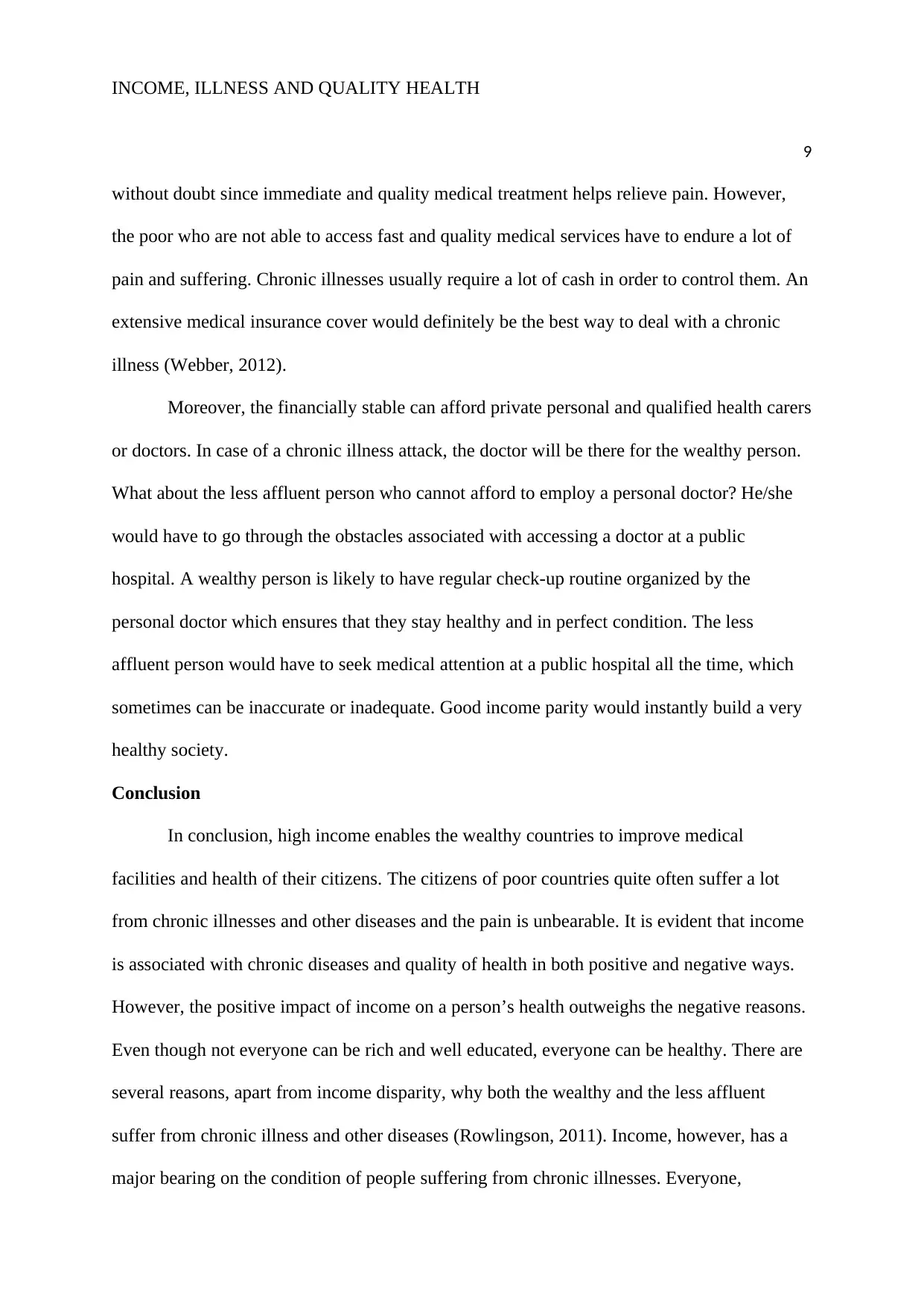
INCOME, ILLNESS AND QUALITY HEALTH
9
without doubt since immediate and quality medical treatment helps relieve pain. However,
the poor who are not able to access fast and quality medical services have to endure a lot of
pain and suffering. Chronic illnesses usually require a lot of cash in order to control them. An
extensive medical insurance cover would definitely be the best way to deal with a chronic
illness (Webber, 2012).
Moreover, the financially stable can afford private personal and qualified health carers
or doctors. In case of a chronic illness attack, the doctor will be there for the wealthy person.
What about the less affluent person who cannot afford to employ a personal doctor? He/she
would have to go through the obstacles associated with accessing a doctor at a public
hospital. A wealthy person is likely to have regular check-up routine organized by the
personal doctor which ensures that they stay healthy and in perfect condition. The less
affluent person would have to seek medical attention at a public hospital all the time, which
sometimes can be inaccurate or inadequate. Good income parity would instantly build a very
healthy society.
Conclusion
In conclusion, high income enables the wealthy countries to improve medical
facilities and health of their citizens. The citizens of poor countries quite often suffer a lot
from chronic illnesses and other diseases and the pain is unbearable. It is evident that income
is associated with chronic diseases and quality of health in both positive and negative ways.
However, the positive impact of income on a person’s health outweighs the negative reasons.
Even though not everyone can be rich and well educated, everyone can be healthy. There are
several reasons, apart from income disparity, why both the wealthy and the less affluent
suffer from chronic illness and other diseases (Rowlingson, 2011). Income, however, has a
major bearing on the condition of people suffering from chronic illnesses. Everyone,
9
without doubt since immediate and quality medical treatment helps relieve pain. However,
the poor who are not able to access fast and quality medical services have to endure a lot of
pain and suffering. Chronic illnesses usually require a lot of cash in order to control them. An
extensive medical insurance cover would definitely be the best way to deal with a chronic
illness (Webber, 2012).
Moreover, the financially stable can afford private personal and qualified health carers
or doctors. In case of a chronic illness attack, the doctor will be there for the wealthy person.
What about the less affluent person who cannot afford to employ a personal doctor? He/she
would have to go through the obstacles associated with accessing a doctor at a public
hospital. A wealthy person is likely to have regular check-up routine organized by the
personal doctor which ensures that they stay healthy and in perfect condition. The less
affluent person would have to seek medical attention at a public hospital all the time, which
sometimes can be inaccurate or inadequate. Good income parity would instantly build a very
healthy society.
Conclusion
In conclusion, high income enables the wealthy countries to improve medical
facilities and health of their citizens. The citizens of poor countries quite often suffer a lot
from chronic illnesses and other diseases and the pain is unbearable. It is evident that income
is associated with chronic diseases and quality of health in both positive and negative ways.
However, the positive impact of income on a person’s health outweighs the negative reasons.
Even though not everyone can be rich and well educated, everyone can be healthy. There are
several reasons, apart from income disparity, why both the wealthy and the less affluent
suffer from chronic illness and other diseases (Rowlingson, 2011). Income, however, has a
major bearing on the condition of people suffering from chronic illnesses. Everyone,
⊘ This is a preview!⊘
Do you want full access?
Subscribe today to unlock all pages.

Trusted by 1+ million students worldwide
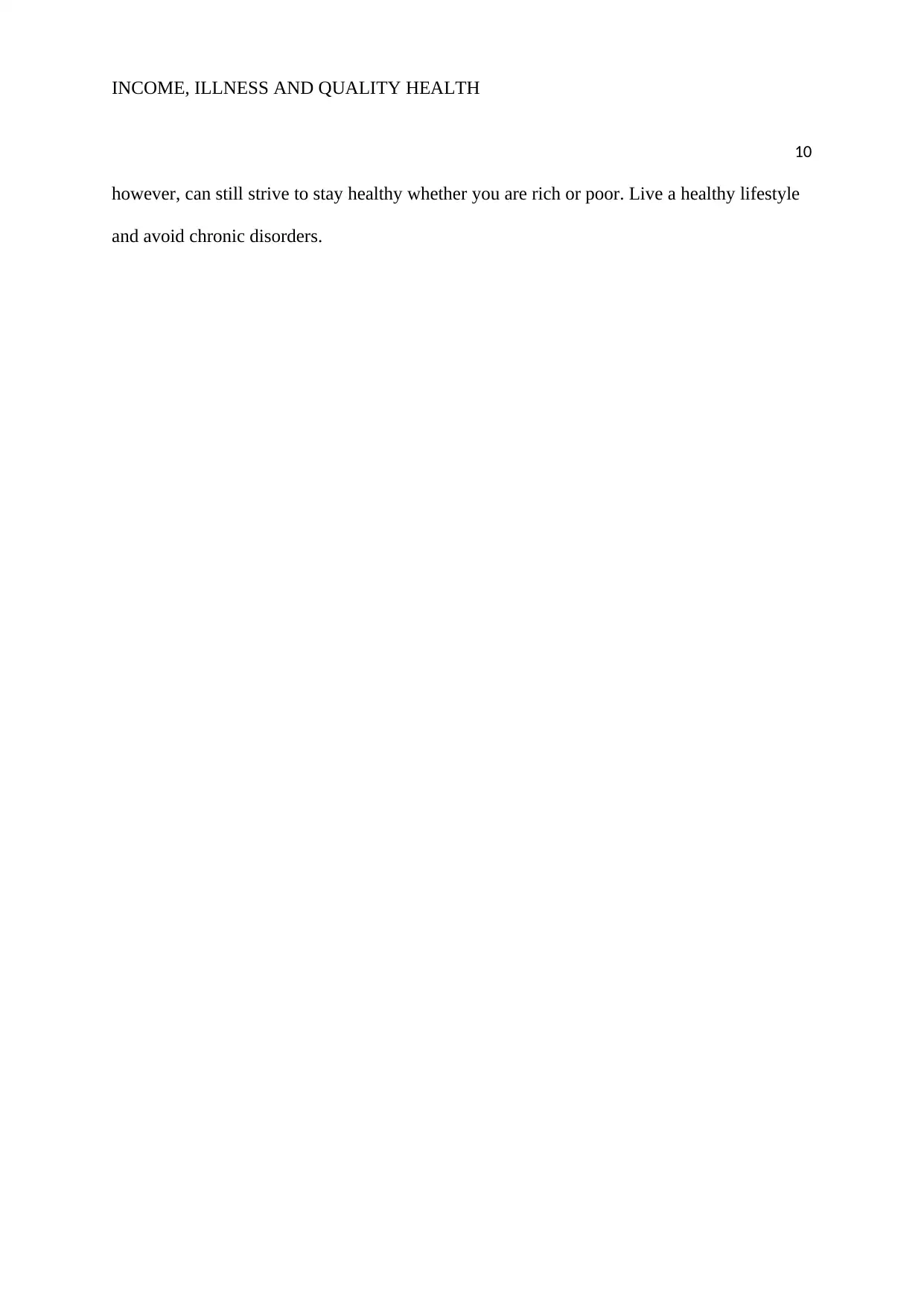
INCOME, ILLNESS AND QUALITY HEALTH
10
however, can still strive to stay healthy whether you are rich or poor. Live a healthy lifestyle
and avoid chronic disorders.
10
however, can still strive to stay healthy whether you are rich or poor. Live a healthy lifestyle
and avoid chronic disorders.
Paraphrase This Document
Need a fresh take? Get an instant paraphrase of this document with our AI Paraphraser
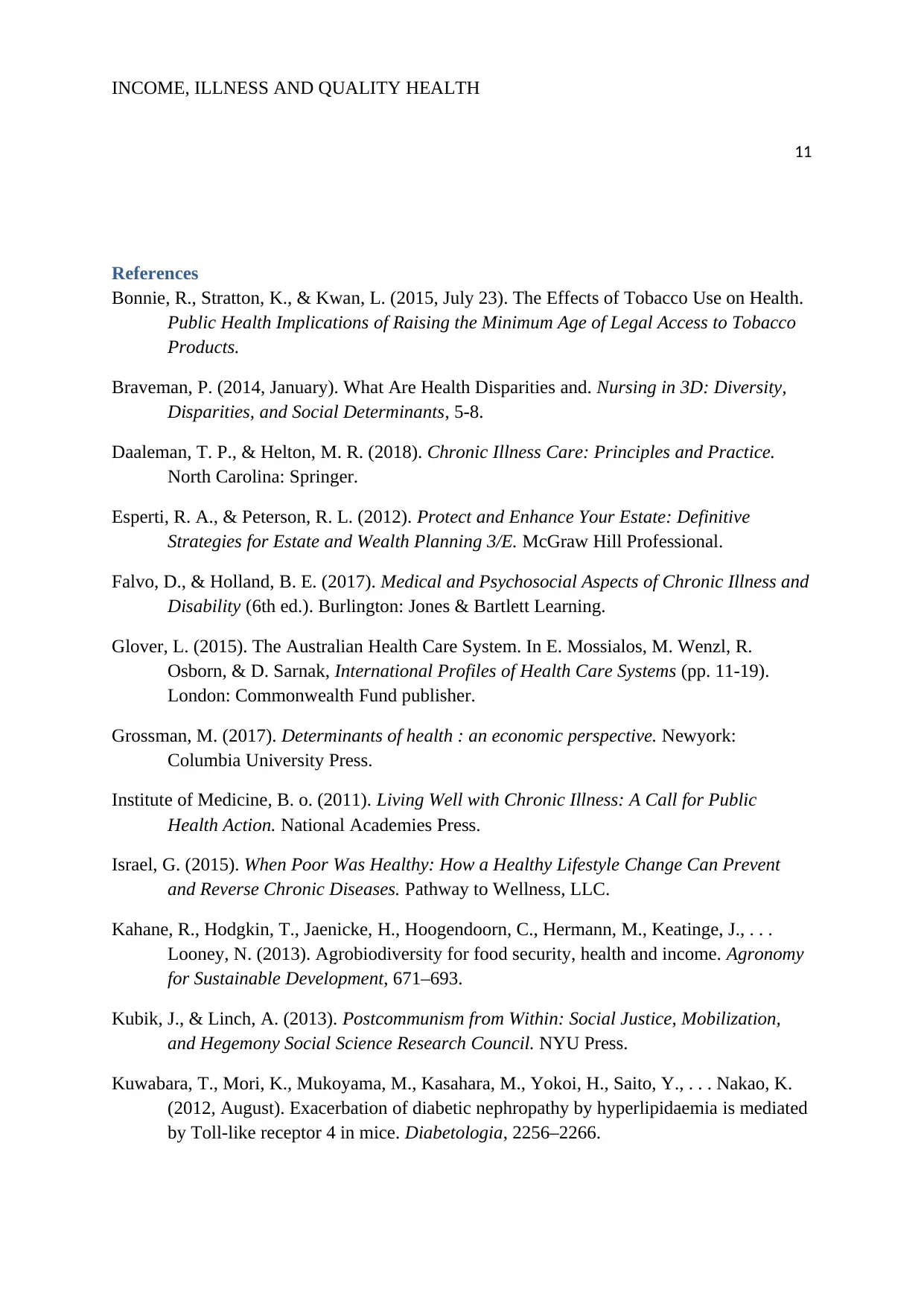
INCOME, ILLNESS AND QUALITY HEALTH
11
References
Bonnie, R., Stratton, K., & Kwan, L. (2015, July 23). The Effects of Tobacco Use on Health.
Public Health Implications of Raising the Minimum Age of Legal Access to Tobacco
Products.
Braveman, P. (2014, January). What Are Health Disparities and. Nursing in 3D: Diversity,
Disparities, and Social Determinants, 5-8.
Daaleman, T. P., & Helton, M. R. (2018). Chronic Illness Care: Principles and Practice.
North Carolina: Springer.
Esperti, R. A., & Peterson, R. L. (2012). Protect and Enhance Your Estate: Definitive
Strategies for Estate and Wealth Planning 3/E. McGraw Hill Professional.
Falvo, D., & Holland, B. E. (2017). Medical and Psychosocial Aspects of Chronic Illness and
Disability (6th ed.). Burlington: Jones & Bartlett Learning.
Glover, L. (2015). The Australian Health Care System. In E. Mossialos, M. Wenzl, R.
Osborn, & D. Sarnak, International Profiles of Health Care Systems (pp. 11-19).
London: Commonwealth Fund publisher.
Grossman, M. (2017). Determinants of health : an economic perspective. Newyork:
Columbia University Press.
Institute of Medicine, B. o. (2011). Living Well with Chronic Illness: A Call for Public
Health Action. National Academies Press.
Israel, G. (2015). When Poor Was Healthy: How a Healthy Lifestyle Change Can Prevent
and Reverse Chronic Diseases. Pathway to Wellness, LLC.
Kahane, R., Hodgkin, T., Jaenicke, H., Hoogendoorn, C., Hermann, M., Keatinge, J., . . .
Looney, N. (2013). Agrobiodiversity for food security, health and income. Agronomy
for Sustainable Development, 671–693.
Kubik, J., & Linch, A. (2013). Postcommunism from Within: Social Justice, Mobilization,
and Hegemony Social Science Research Council. NYU Press.
Kuwabara, T., Mori, K., Mukoyama, M., Kasahara, M., Yokoi, H., Saito, Y., . . . Nakao, K.
(2012, August). Exacerbation of diabetic nephropathy by hyperlipidaemia is mediated
by Toll-like receptor 4 in mice. Diabetologia, 2256–2266.
11
References
Bonnie, R., Stratton, K., & Kwan, L. (2015, July 23). The Effects of Tobacco Use on Health.
Public Health Implications of Raising the Minimum Age of Legal Access to Tobacco
Products.
Braveman, P. (2014, January). What Are Health Disparities and. Nursing in 3D: Diversity,
Disparities, and Social Determinants, 5-8.
Daaleman, T. P., & Helton, M. R. (2018). Chronic Illness Care: Principles and Practice.
North Carolina: Springer.
Esperti, R. A., & Peterson, R. L. (2012). Protect and Enhance Your Estate: Definitive
Strategies for Estate and Wealth Planning 3/E. McGraw Hill Professional.
Falvo, D., & Holland, B. E. (2017). Medical and Psychosocial Aspects of Chronic Illness and
Disability (6th ed.). Burlington: Jones & Bartlett Learning.
Glover, L. (2015). The Australian Health Care System. In E. Mossialos, M. Wenzl, R.
Osborn, & D. Sarnak, International Profiles of Health Care Systems (pp. 11-19).
London: Commonwealth Fund publisher.
Grossman, M. (2017). Determinants of health : an economic perspective. Newyork:
Columbia University Press.
Institute of Medicine, B. o. (2011). Living Well with Chronic Illness: A Call for Public
Health Action. National Academies Press.
Israel, G. (2015). When Poor Was Healthy: How a Healthy Lifestyle Change Can Prevent
and Reverse Chronic Diseases. Pathway to Wellness, LLC.
Kahane, R., Hodgkin, T., Jaenicke, H., Hoogendoorn, C., Hermann, M., Keatinge, J., . . .
Looney, N. (2013). Agrobiodiversity for food security, health and income. Agronomy
for Sustainable Development, 671–693.
Kubik, J., & Linch, A. (2013). Postcommunism from Within: Social Justice, Mobilization,
and Hegemony Social Science Research Council. NYU Press.
Kuwabara, T., Mori, K., Mukoyama, M., Kasahara, M., Yokoi, H., Saito, Y., . . . Nakao, K.
(2012, August). Exacerbation of diabetic nephropathy by hyperlipidaemia is mediated
by Toll-like receptor 4 in mice. Diabetologia, 2256–2266.
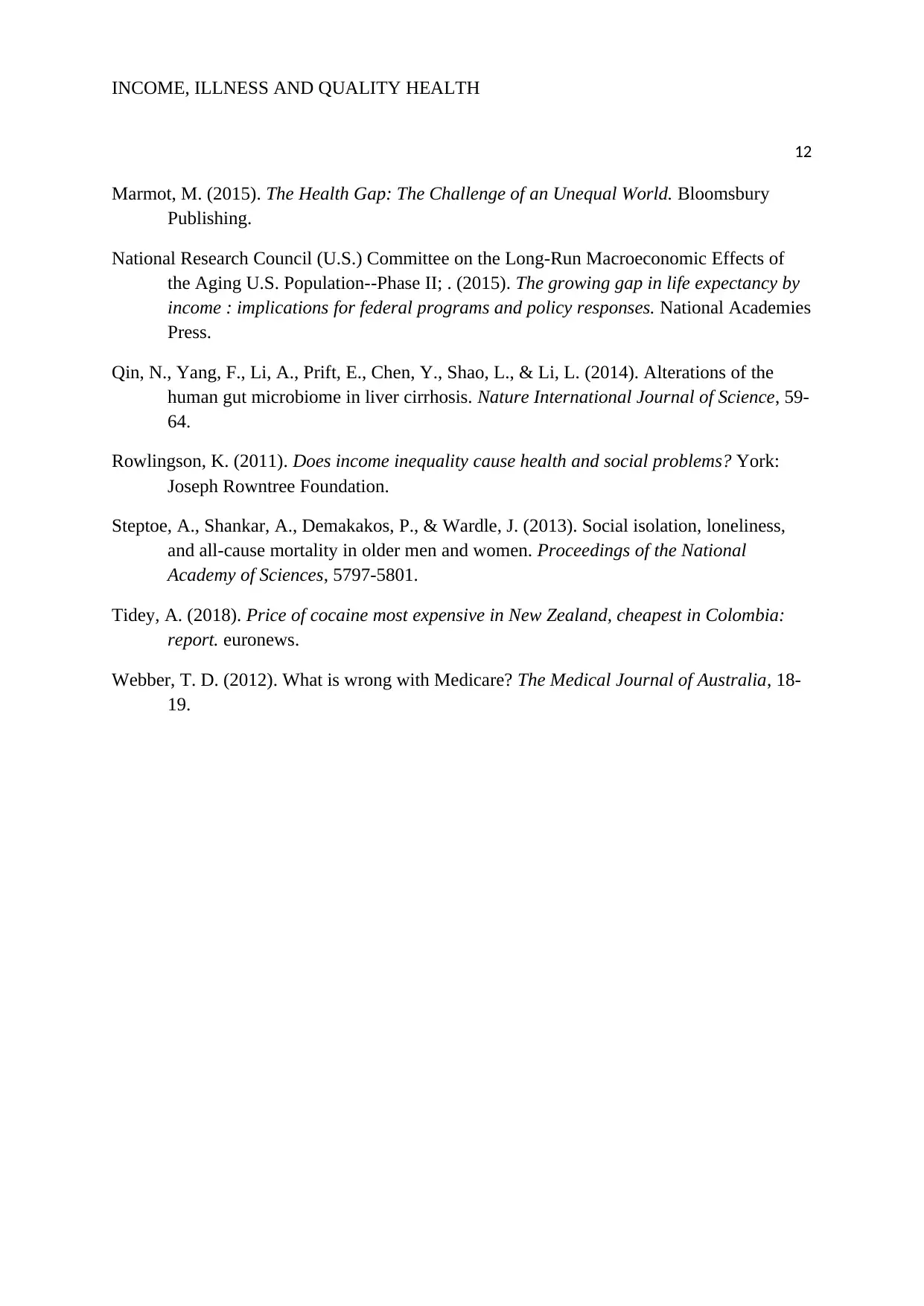
INCOME, ILLNESS AND QUALITY HEALTH
12
Marmot, M. (2015). The Health Gap: The Challenge of an Unequal World. Bloomsbury
Publishing.
National Research Council (U.S.) Committee on the Long-Run Macroeconomic Effects of
the Aging U.S. Population--Phase II; . (2015). The growing gap in life expectancy by
income : implications for federal programs and policy responses. National Academies
Press.
Qin, N., Yang, F., Li, A., Prift, E., Chen, Y., Shao, L., & Li, L. (2014). Alterations of the
human gut microbiome in liver cirrhosis. Nature International Journal of Science, 59-
64.
Rowlingson, K. (2011). Does income inequality cause health and social problems? York:
Joseph Rowntree Foundation.
Steptoe, A., Shankar, A., Demakakos, P., & Wardle, J. (2013). Social isolation, loneliness,
and all-cause mortality in older men and women. Proceedings of the National
Academy of Sciences, 5797-5801.
Tidey, A. (2018). Price of cocaine most expensive in New Zealand, cheapest in Colombia:
report. euronews.
Webber, T. D. (2012). What is wrong with Medicare? The Medical Journal of Australia, 18-
19.
12
Marmot, M. (2015). The Health Gap: The Challenge of an Unequal World. Bloomsbury
Publishing.
National Research Council (U.S.) Committee on the Long-Run Macroeconomic Effects of
the Aging U.S. Population--Phase II; . (2015). The growing gap in life expectancy by
income : implications for federal programs and policy responses. National Academies
Press.
Qin, N., Yang, F., Li, A., Prift, E., Chen, Y., Shao, L., & Li, L. (2014). Alterations of the
human gut microbiome in liver cirrhosis. Nature International Journal of Science, 59-
64.
Rowlingson, K. (2011). Does income inequality cause health and social problems? York:
Joseph Rowntree Foundation.
Steptoe, A., Shankar, A., Demakakos, P., & Wardle, J. (2013). Social isolation, loneliness,
and all-cause mortality in older men and women. Proceedings of the National
Academy of Sciences, 5797-5801.
Tidey, A. (2018). Price of cocaine most expensive in New Zealand, cheapest in Colombia:
report. euronews.
Webber, T. D. (2012). What is wrong with Medicare? The Medical Journal of Australia, 18-
19.
⊘ This is a preview!⊘
Do you want full access?
Subscribe today to unlock all pages.

Trusted by 1+ million students worldwide
1 out of 12
Related Documents
Your All-in-One AI-Powered Toolkit for Academic Success.
+13062052269
info@desklib.com
Available 24*7 on WhatsApp / Email
![[object Object]](/_next/static/media/star-bottom.7253800d.svg)
Unlock your academic potential
Copyright © 2020–2025 A2Z Services. All Rights Reserved. Developed and managed by ZUCOL.





